学习记录
7.10 安装、官网、StanfordTF Course
7.11 - StanfordTF Course
8.6 - 知乎资料学习
1.Tensorflow官网
https://www.tensorflow.org/get_started/get_started_for_beginners
安装Tensorflow
- 直接在pytharm下安装
图和会话
- https://www.tensorflow.org/programmers_guide/graphs
- tf.Graph:包含图结构和图集合
- tf.Graph 对象会为其包含的 tf.Operation 对象定义一个命名空间。TensorFlow 会自动为您的图中的每个指令选择一个唯一名称,但您也可以指定描述性名称,使您的程序阅读和调试起来更轻松。TensorFlow API 提供两种方法来覆盖操作名称:
2.Stanford TF 2017:
- CS 20SI: Tensorflow for Deep Learning Research
Lecture1
- Tensorflow的主要特点是将定义计算(definition of computation)和执行计算(execution of computation)
-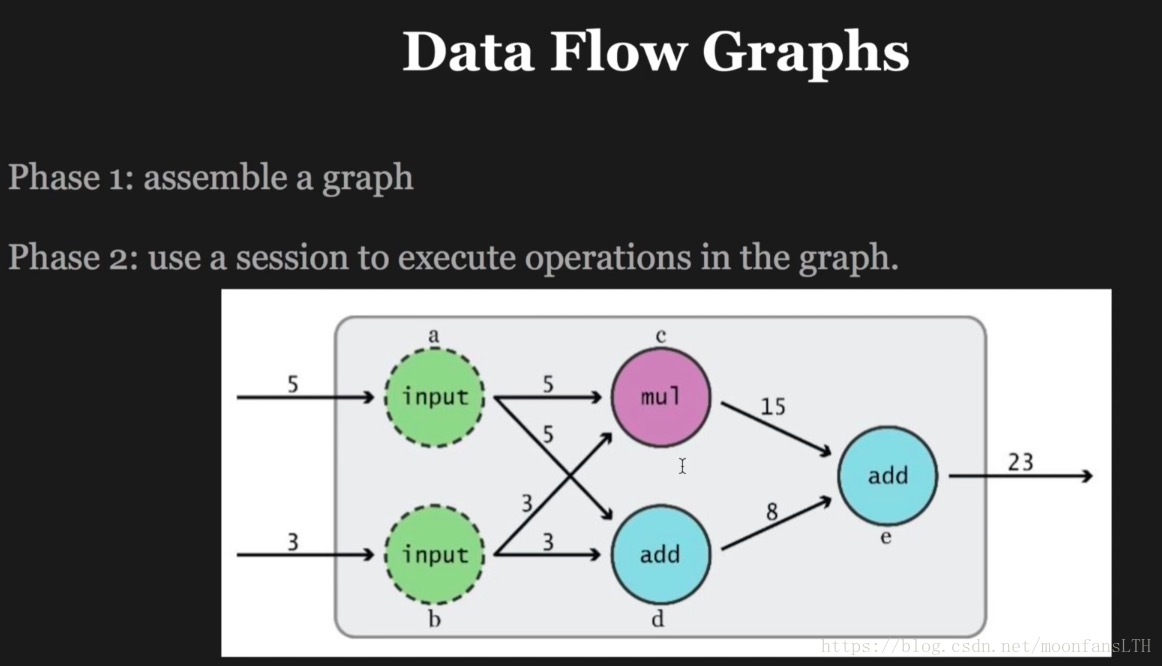
- 操作、变量、常量组合在一起就是一个tensor
- tensor只会定义一个计算图,需要通过session来fetch the value of a graph
- 构建graph的步骤:
- 创建新图
- 设置为默认图(no more than one graph)
- 添加节点
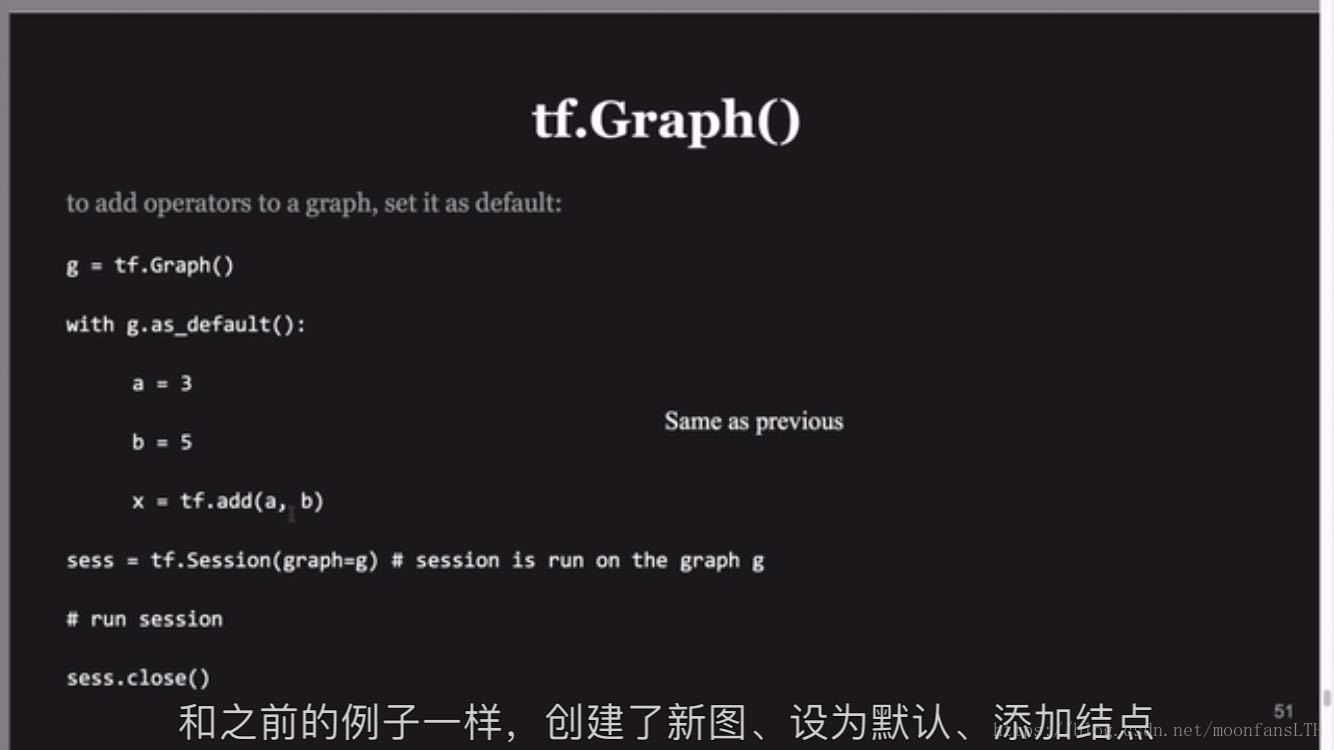
- 如果有两个graph(default_graph 和 user_graph)
使用graph的好处:
- 可以只计算需要的某个子图(subgraph)
- 是一种分布式预算的设计思路,利于分布式计算
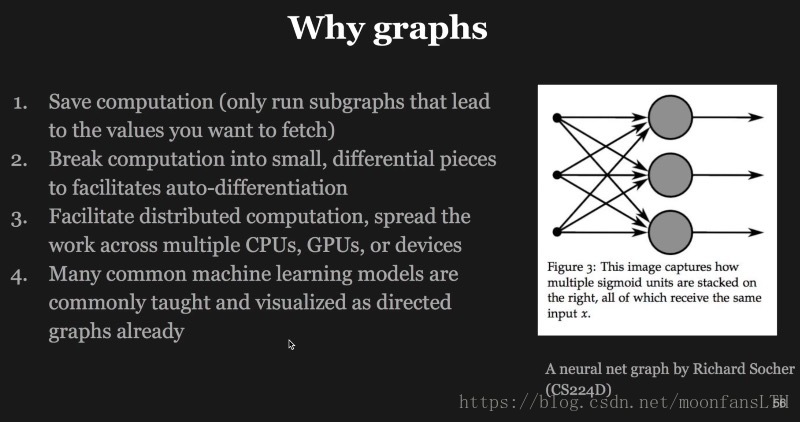
调试代码时出现这个问题,明天去看看
- Your CPU supports instructions that this TensorFlow binary was not compiled to use: AVX2 FMA 通过tensorflow编译安装获取底层的CPU加速接口。
- TensorFlow如何充分使用所有CPU核数,提高TensorFlow的CPU使用率,以及Intel的MKL加速
- http://nooverfit.com/wp/tensorflow如何充分使用所有cpu核数,提高tensorflow的cpu使用率

Lecture2 OPs
- numpy broadcast特性
- https://www.youtube.com/watch?v=9kC836XhICU
- numpy.broadcast
- 广播用以描述numpy中对两个形状不同的阵列进行数学计算的处理机制。较小的阵列“广播”到较大阵列相同的形状尺度上,使它们对等以进行数学计算。广播提供了一种向量化阵列的操作方式,因此Python不需要像C一样循环。广播操作不需要数据复制,通常执行效率非常高。然而,有时广播是个坏主意,可能会导致内存浪费以致计算减慢。
- 向量被stretching to be the compatible shape
- https://www.cnblogs.com/yangmang/p/7125458.html
- 广播原则:如果两个数组的后缘维度(即:从末尾开始算起的维度)的轴长相符或其中一方的长度为1,则认为它们是广播兼容的,广播会在缺失和(或)长度为1的轴上进行。
- 理解后缘轴长度
- 感觉最好不要用,代码可读性差。
Constants
- tf.constant(value, dtype=None, shape=None, name=’Const’, verify_shape=False)
- verify_shape用来校验value 和 shape是否一致
- 如果想直接查看tf的值,可以开启tf.InteractiveSession()模式,通过a.eval()查看a的结构和内容(而不是通过session来执行)
- as it avoids having to pass an explicit Session object to run ops.
Tensors filled with specific value
- tf.zeros(shape, dtype=tf.float32, name=None)
- tf.zeros_like(input_tensor, dtype=None, name=None, optimize=True)
- tf.ones / tf.ones_like
- tf.fill(dims, value, name=None)
- tf.fill([2,3],8) => [[8,8,8],[8,8,8]]
Constants as sequences
- tf.linspace()
- tf.range(start, limit, delta, dtype, name)
Randomly generated constants
- tf.random_normal()
- tf.truncated_normal()
- 截断正态分布是截断分布(Truncated Distribution)的一种,那么截断分布是什么?截断分布是指限制变量x取值范围(scope)的一种分布。
- 正态分布,如果随机数偏离均值超过2个标准差,就重新随机
- tf.random_uniform()
- tf.random_shuffle()
- 对张量的内容进行排序
- tf.random_crop()
- tf.multinomial()
- tf.random_gamma()
- tf.set_random_seed(seed)
Operations

- tf.add_n([a,b,b]) => a+b+b
- tf.matmul(a,b) 矩阵相乘,如果维数不对应,通过 tf.reshape(a,[m,n]) 变换
Tensorflow Data type
- takes Python natives types: boolean, numeric(int, float), strings

- ones_like返回与原tensor相同type的数据,如果输入是字符型,则error,因为1不是string.
- Do not use Python native types for tensors because TF has to infer Python type.
- Constants were stored in graph, which makes loading graphs expensive when constants are big.
Variables
- 定义variable时指定类型和初始值
- tf.Variable is a class, but tf.constant is an op
- 初始化
- 变量使用前需要初始化:
- https://blog.youkuaiyun.com/yjk13703623757/article/details/77075711
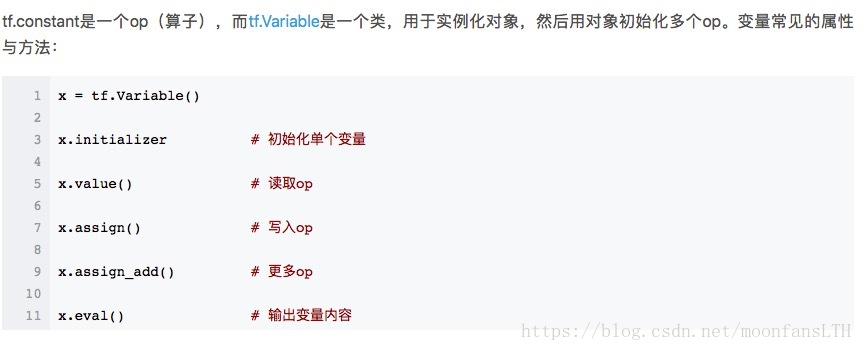
- 全局初始化:
init = tf.global_variables_initializer()
with tf.Session() as sess:
sess.run(init)
init_ab = tf.variables_initializer([a,b],name="init_ab")
with tf.Session() as sess:
sess.run(init_ab)
w = tf.Variable(xxx)
with tf.Session() as sess:
sess.run(w.initializer)- Eval() a variable,获取variable的取值
with tf.Session() as sess:
sess.run(w.initializer)
print w.eval()- tf.Variable.assign()
- 赋值语句
- .assign()是一个op,需要在session里执行过才会生效
with tf.Session() as sess:
sess.run(w.initializer)
sess.run(w.assign(100))
print w.eval()Use a variable to initialize another variable
- 如果一个变量依赖另一个变量的值,需要另一个变量initialize。可以直接用:
- u=tf.Variable(2* w.intialized_value())
- 如果一个变量依赖另一个变量的值,需要另一个变量initialize。可以直接用:
Session vs InteractiveSession
- The only differences is an InteractiveSession makes itself the default.
Control Dependencies
- defines which ops should be run first
- tf.Graph.control_dependencies(control_inputs)
Placeholders
- 作用:
- Can assemble the graph first without knowing the values needed for computation.
- placeholder是TensorFlow的占位符节点,由placeholder方法创建,其也是一种常量,但是由用户在调用run方法是传递的,也可以将placeholder理解为一种形参。即其不像constant那样直接可以使用,需要用户传递常数值。
- feed the values to placeholders using a dictionary.
- tf.placeholder(dtype, shape=None, name=None)
#当你要run的session里的OP包含placeholder时,需要对placeholder赋值
a=tf.placeholder(tf.float32, shape=[3])
b=tf.constant([5,5,5], tf.float32)
c=a+b
with tf.Session() as sess:
print sess.run(c,feed_dict={a:[1,2,3]})- test if a tensor is feedable
- tf.Graph.is_feedable(tensor)
Lazy loading
- Put in the OP during execution
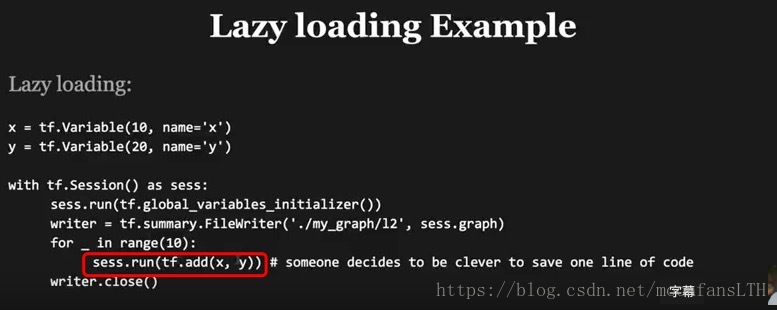
- 坏处:没有显示地显示 tf.add这个节点,不易于tensorboard的graph阅读。
一个case
- 把weight、bias、incoming设定为variable,便于optimize更新参数
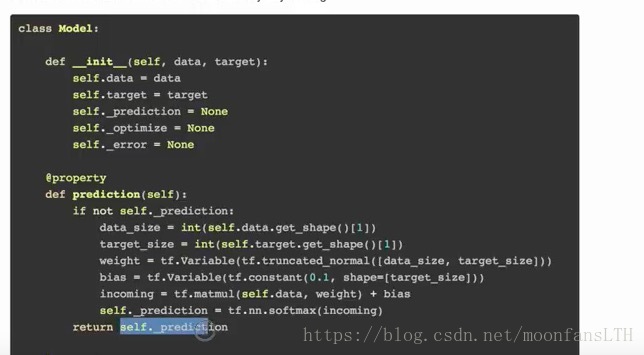

Lecture3 Basic models
linear model case problems
- optimizer = tf.train.GradientDescentOptimizer(learning_rate=0.001).minimize(loss)
- 梯度下降优化函数的原理,直接输入loss function,形式定义要求
- API文档:https://www.tensorflow.org/api_docs/python/tf/train/GradientDescentOptimizer
- 原理:looks at all trainable variables that optimizer depends on and update them in a loop
- 里面被训练的variable是 tf.Variable()中trainable=True的所有变量
- _, l = sess.run([optimizer, loss], feed_dict={X: x, Y: y})
- sess.run中run的对象填写要求,取_是因为该函数return的值用不到
- tf中的条件判断:没有if a-b>d then ,需要构建condition
- optimizer = tf.train.GradientDescentOptimizer(learning_rate=0.001).minimize(loss)
logistic regression(MINST)
- target:
- target:
Lecture4 Structure your models
- word2vec
- https://blog.youkuaiyun.com/mylove0414/article/details/61616617
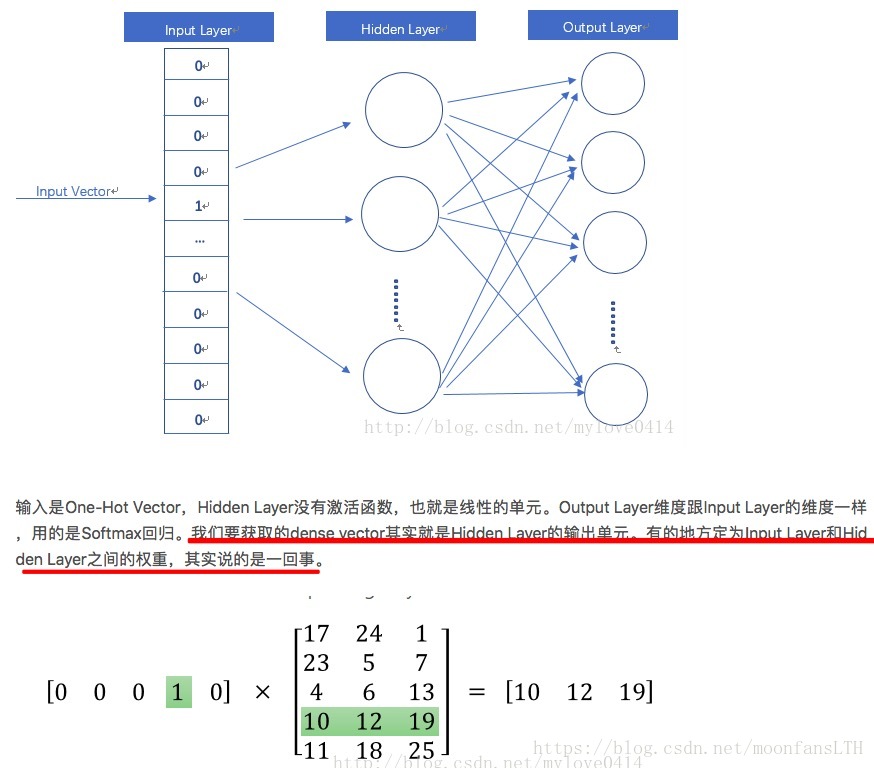
- https://zhuanlan.zhihu.com/p/37176454
- http://mccormickml.com/2016/04/19/word2vec-tutorial-the-skip-gram-model/
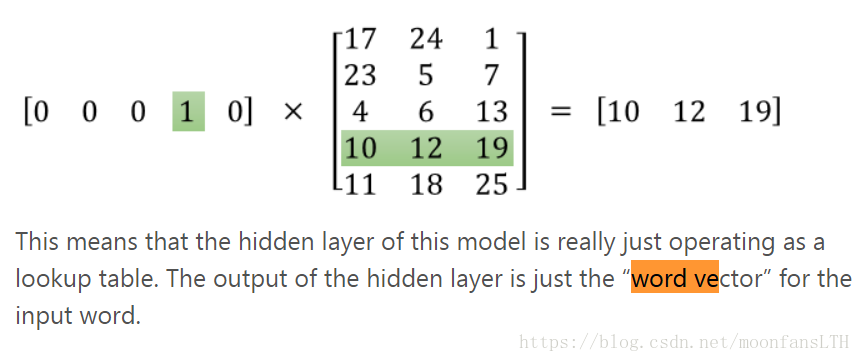
- If two different words have very similar “contexts” (that is, what words are likely to appear around them), then our model needs to output very similar results for these two words.
- Sturcture a tensorflow model
Word embedding
- 含义:capture the semantic relationships between words.
- count & predict
- CBOW和Skip-gram
- continus bag-of-words / skip-gram
- https://zhuanlan.zhihu.com/p/35074402
- 含义:capture the semantic relationships between words.
NCE(noise contrastive estimation)
- PDF:https://arxiv.org/pdf/1410.8251.pdf
- 直接计算softmax成本非常大(需要遍历所有v个单词)
- https://blog.youkuaiyun.com/littlely_ll/article/details/79252064
- 噪音对比估计
- 假设X=(x1,x2,⋯,xTd)是从真实的数据(或语料库)中抽取样本,但是样本服从什么样的分布我们不知道,那么先假设其中的每个xi服从一个未知的概率密度函数pd。这样我们需要一个相对可参考的分布反过来去估计概率密度函数pd,这个可参考的分布或称之为噪音分布应该是我们知道的,比如高斯分布,均匀分布等。假设这个噪音分布的概率密度函数为pn,从中抽取样本数据为Y=(y1,y2,⋯,yTn),而这个数据称之为噪声样本,我们的目的就是通过学习一个分类器把这两类样本区别开来,并能从模型中学到数据的属性,噪音对比估计的思想就是“通过比较而学习”。
- PDF:https://arxiv.org/pdf/1410.8251.pdf
- namescope: group nodes together
- http://web.stanford.edu/class/cs20si/lectures/notes_04.pdf
- 主要是为了在tensorboard中 visualization 好理解
- word2vec代码
Lecture5 Manage your experiment
- more word2vec
- tf.gradients:求导公式
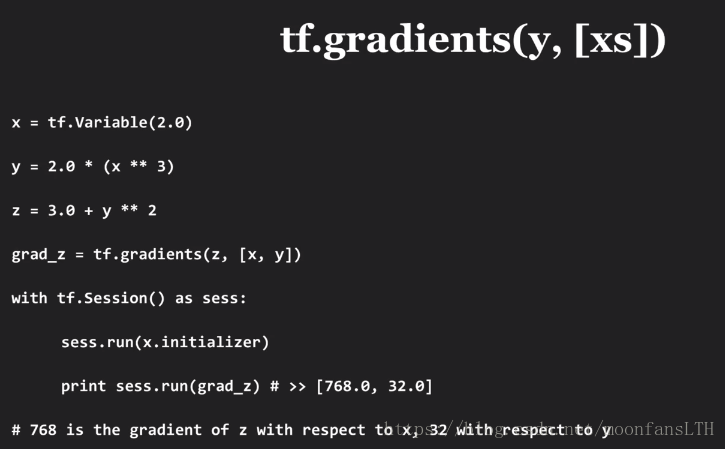
构建tf graph时可以用这样一个框架
- structure model
- def load_data(self)
- feel free to add instance variables to model object that store loaded data
- def add_placeholders(self)
- add placeholders variables to tensorflow computational graph
- def create_feed_dict(self, input_batch, label_batch)
- creates the feed_dict for training the given step
- def add_model(self, input_data)
- implements core of model that transform input_data into predictions
- def add_loss_op(self, pred)
- adds ops for loss to the computational graph
- def run_epoch(self, sess, input_data, input_labels)
- trains the model for one-epoch
- def fit(self, sess, input_data, input_labels)
- fit model on the provided data
- def predict(self, sess, input_data, input_labels=None)
- make predictions from the provided model
- def load_data(self)
- language model(model) –从model中继承
- def add_embedding(self)
- add embedding layer, that maps from vocabulary to vectors
- def add_embedding(self)
- 代码的规范
- structure model
manage experiments
- tf.train.Saver
- saves graph’s variables in binary files
- tf.train.Saver.save(sess, save_path, global_step=None…)
- self.global_step
- tf.Variable(10, trainable=False, name=’global_step’)
- https://www.tensorflow.org/versions/r1.8/api_docs/python/tf/train/global_step?hl=zh-cn
- https://blog.youkuaiyun.com/leviopku/article/details/78508951
-save your model
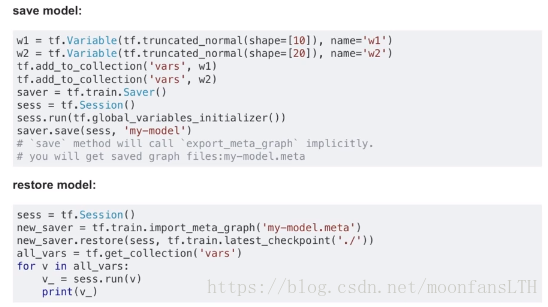
- tf.train.Saver
tf.summary: visualize our summary statistics during our training
- tf.summary.scalar :loss function的取值
- tf.summary.histogram:weights
- tf.summary.image
- Step1:create summaries
- Step2:run them
- Step3:write summary to file
- 在tensor board中查看结果
L6 Intuition Behind Backpropagation as a Computational Graph
- BP:https://www.youtube.com/watch?v=u2OeYrlAx_A
- http://cs231n.github.io/optimization-2/#grad
- 计算梯度的对象是Final Loss function
- 如果上一层的神经元是多个,反向传播时如何处理?
- add up
- 矩阵求导x`
- https://blog.youkuaiyun.com/dinkwad/article/details/72819832
- 标量对矩阵的求导
- 矩阵对矩阵的求导
学习 CS231n: Convolutional Neural Networks for Visual Recognition.
Backpropagation, Intuitions
3.知乎神贴
白话TensorFlow+实战系列
- https://zhuanlan.zhihu.com/p/26454768
- 常用损失函数
- 分类问题的交叉熵:
- pred = tf.matmal(x,w)+b
- loss = tf.nn.softmax_cross_entropy_with_logits(pred,y)
- 回归问题的MSE:
- loss = tf.reduce_mean(tf.square(pred-y))
- 分类问题的交叉熵:
- 学习率
- 指数衰减型:
- learning_rate = tf.train.exponential_decay(0.1, global_step, 100, 0.98, staircase = True)
- 过拟合
- L1:tf.contrib.layers.l1_regularizer(lambda)(w)
- L2:tf.contrib.layers.l2_regularizer(lambda)(w)
- 指数衰减型:
- example
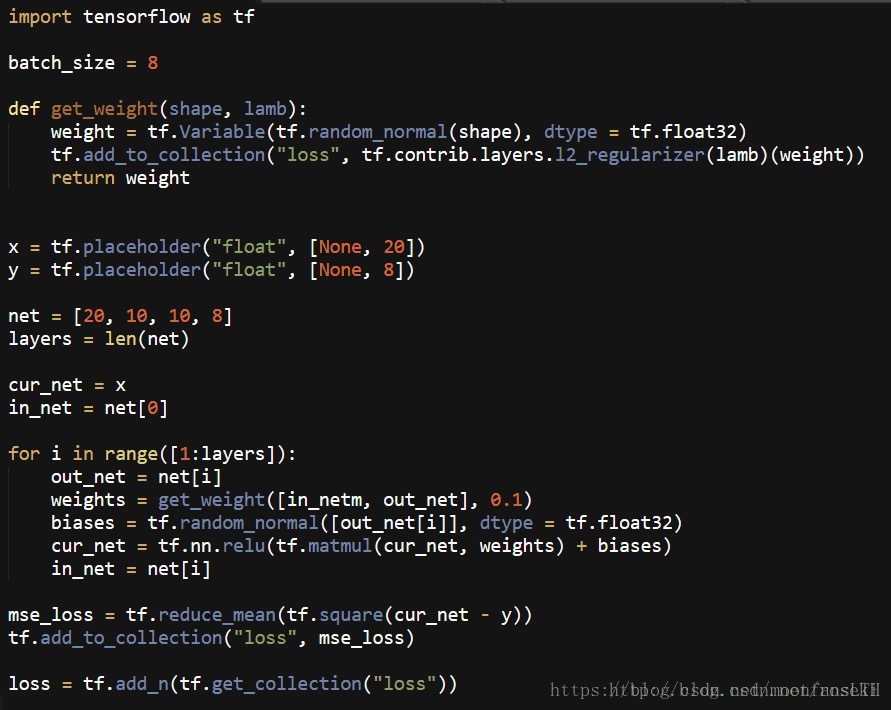
- 构建了一个[20,10,10,8]的全连接神经网络
- 其中get_weight函数用于获取每一层的权重w并进行L2正则化后放入collection中进行管理。 collection 是个啥玩意儿
- cur_net表示的是当前神经网络层。
- in_net与out_net表示的是相邻的两层,用于构建权重。注意两层之间参数的传递和迭代
- for循环就是构建网络过程。
- mse_loss就是均方差损失函数。
- 最后一并加入collection中,全部相加就得到最后的loss。
- 滑动平均模型
- tf.train.ExponentialMovingAverage
- 该函数会为每一个变量生成一个影子变量(shadow_variable),影子变量的初始值即为变量的初始值,随后影子变量由该方程进行改变:
- shadow_variable = decay * shadow_variable + (1 - decay) * variable
- 变量管理
- 基于字典的方法创建变量
- 用字典的方式,key就是你取的网络层名字,value就是神经网络各层的变量。

- 使用变量时直接提取dict里的对象

- 变量共享
- 该方法主要是通过tf.get_variable()与tf.variable_scope()函数来实现。
- tf.get_variable() 获取变量或创建变量
- tf.variable_scope() 创建变量的命名空间,当reuse = True时,指明在该管理器中,tf.get_variable()用于获取已经创建的变量;当reuse = False时,指明在该管理器中,tf.get_variable()用于创建变量。

- 创建时reuse=False,调用参数时设置resue=True
- 创建变量的方法对比
- tf.Variable() 与 tf.get_variable()
- 共同点:都是用于在一个name_scope下获取或创建一个变量的方式
- 区别:
- 前者用于创建一个新变量,在同一个name_scope下可以创建相同名字的变量,底层实现会自动引入别名机制,两次调用产生两个不同的变量。
- 后者用于获取一个变量,且不受name_scope约束,变量的name只包含variable_scope,若这个变量已存在,则自动获取;若不存在,则自动创建一个变量。
- 如图所示,get_variable创建的变量不包含name_scope属性

- tf.variable_scope() 与 tf.name_scope()
- name_scope用于管理一个图里的各种op,返回的是一个以scope_name命名的context manager,一个name_scope下可定义各种op活name_scope,避免各个op之间冲突。
- variable_scope一般与get_variable()配合使用,用于管理一个graph中变量的名字,避免变量之间的命名冲突,它允许在一个variable_scope下共享变量。
- tf.Variable() 与 tf.get_variable()
- 变量共享:
- 在 TensorFlow 中,我们定义一个变量,相当于往 Graph 中添加了一个节点。和普通的 python 函数不一样,在一般的函数中,我们对输入进行处理,然后返回一个结果,而函数里边定义的一些局部变量我们就不管了。但是在 TensorFlow 中,我们在函数里边创建了一个变量,就是往 Graph 中添加了一个节点。出了这个函数后,这个节点还是存在于 Graph 中的。
- https://blog.youkuaiyun.com/selous/article/details/77095155?locationNum=9&fps=1
- 同一个项目下共享(在定义后紧接着使用),需添加 scopre.reuse_variables()
- tf.variable, tf.placeholder 的区别
- https://blog.youkuaiyun.com/shenxiaoming77/article/details/79141078
- tf.placeholder() 占位符。* trainable==False *
- tf.Variable() 一般变量用这种方式定义。 * 可以选择 trainable 类型 *
- tf.get_variable() 一般都是和 tf.variable_scope() 配合使用,从而实现变量共享的功能。 * 可以选择 trainable 类型 *
- 基于字典的方法创建变量








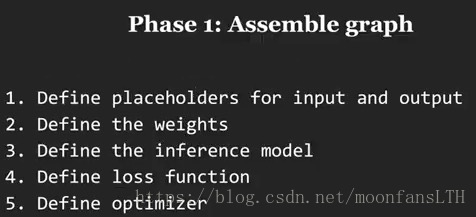
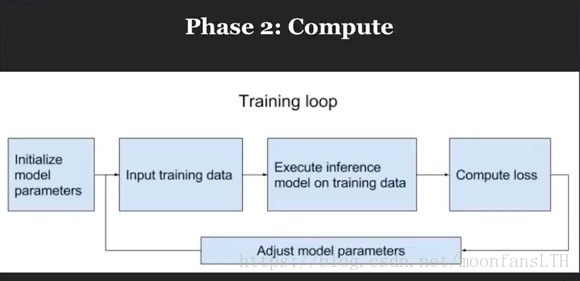




















 2445
2445

 被折叠的 条评论
为什么被折叠?
被折叠的 条评论
为什么被折叠?








